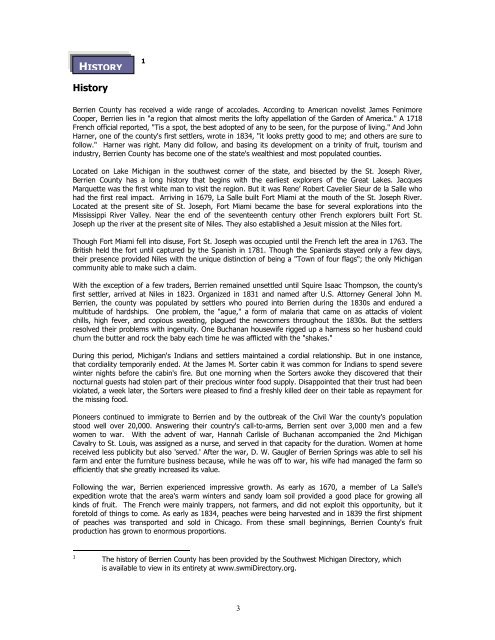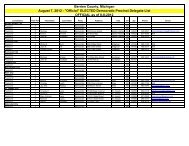Community Profile - Berrien County
Community Profile - Berrien County
Community Profile - Berrien County
You also want an ePaper? Increase the reach of your titles
YUMPU automatically turns print PDFs into web optimized ePapers that Google loves.
HISTORY<br />
History<br />
1<br />
<strong>Berrien</strong> <strong>County</strong> has received a wide range of accolades. According to American novelist James Fenimore<br />
Cooper, <strong>Berrien</strong> lies in "a region that almost merits the lofty appellation of the Garden of America." A 1718<br />
French official reported, "Tis a spot, the best adopted of any to be seen, for the purpose of living." And John<br />
Harner, one of the county's first settlers, wrote in 1834, "it looks pretty good to me; and others are sure to<br />
follow." Harner was right. Many did follow, and basing its development on a trinity of fruit, tourism and<br />
industry, <strong>Berrien</strong> <strong>County</strong> has become one of the state's wealthiest and most populated counties.<br />
Located on Lake Michigan in the southwest corner of the state, and bisected by the St. Joseph River,<br />
<strong>Berrien</strong> <strong>County</strong> has a long history that begins with the earliest explorers of the Great Lakes. Jacques<br />
Marquette was the first white man to visit the region. But it was Rene’ Robert Cavelier Sieur de la Salle who<br />
had the first real impact. Arriving in 1679, La Salle built Fort Miami at the mouth of the St. Joseph River.<br />
Located at the present site of St. Joseph, Fort Miami became the base for several explorations into the<br />
Mississippi River Valley. Near the end of the seventeenth century other French explorers built Fort St.<br />
Joseph up the river at the present site of Niles. They also established a Jesuit mission at the Niles fort.<br />
Though Fort Miami fell into disuse, Fort St. Joseph was occupied until the French left the area in 1763. The<br />
British held the fort until captured by the Spanish in 1781. Though the Spaniards stayed only a few days,<br />
their presence provided Niles with the unique distinction of being a "Town of four flags"; the only Michigan<br />
community able to make such a claim.<br />
With the exception of a few traders, <strong>Berrien</strong> remained unsettled until Squire Isaac Thompson, the county's<br />
first settler, arrived at Niles in 1823. Organized in 1831 and named after U.S. Attorney General John M.<br />
<strong>Berrien</strong>, the county was populated by settlers who poured into <strong>Berrien</strong> during the 1830s and endured a<br />
multitude of hardships. One problem, the "ague," a form of malaria that came on as attacks of violent<br />
chills, high fever, and copious sweating, plagued the newcomers throughout the 1830s. But the settlers<br />
resolved their problems with ingenuity. One Buchanan housewife rigged up a harness so her husband could<br />
churn the butter and rock the baby each time he was afflicted with the "shakes."<br />
During this period, Michigan's Indians and settlers maintained a cordial relationship. But in one instance,<br />
that cordiality temporarily ended. At the James M. Sorter cabin it was common for Indians to spend severe<br />
winter nights before the cabin's fire. But one morning when the Sorters awoke they discovered that their<br />
nocturnal guests had stolen part of their precious winter food supply. Disappointed that their trust had been<br />
violated, a week later, the Sorters were pleased to find a freshly killed deer on their table as repayment for<br />
the missing food.<br />
Pioneers continued to immigrate to <strong>Berrien</strong> and by the outbreak of the Civil War the county's population<br />
stood well over 20,000. Answering their country's call-to-arms, <strong>Berrien</strong> sent over 3,000 men and a few<br />
women to war. With the advent of war, Hannah Carlisle of Buchanan accompanied the 2nd Michigan<br />
Cavalry to St. Louis, was assigned as a nurse, and served in that capacity for the duration. Women at home<br />
received less publicity but also 'served.' After the war, D. W. Gaugler of <strong>Berrien</strong> Springs was able to sell his<br />
farm and enter the furniture business because, while he was off to war, his wife had managed the farm so<br />
efficiently that she greatly increased its value.<br />
Following the war, <strong>Berrien</strong> experienced impressive growth. As early as 1670, a member of La Salle's<br />
expedition wrote that the area's warm winters and sandy loam soil provided a good place for growing all<br />
kinds of fruit. The French were mainly trappers, not farmers, and did not exploit this opportunity, but it<br />
foretold of things to come. As early as 1834, peaches were being harvested and in 1839 the first shipment<br />
of peaches was transported and sold in Chicago. From these small beginnings, <strong>Berrien</strong> <strong>County</strong>'s fruit<br />
production has grown to enormous proportions.<br />
1 The history of <strong>Berrien</strong> <strong>County</strong> has been provided by the Southwest Michigan Directory, which<br />
is available to view in its entirety at www.swmiDirectory.org.<br />
3
















